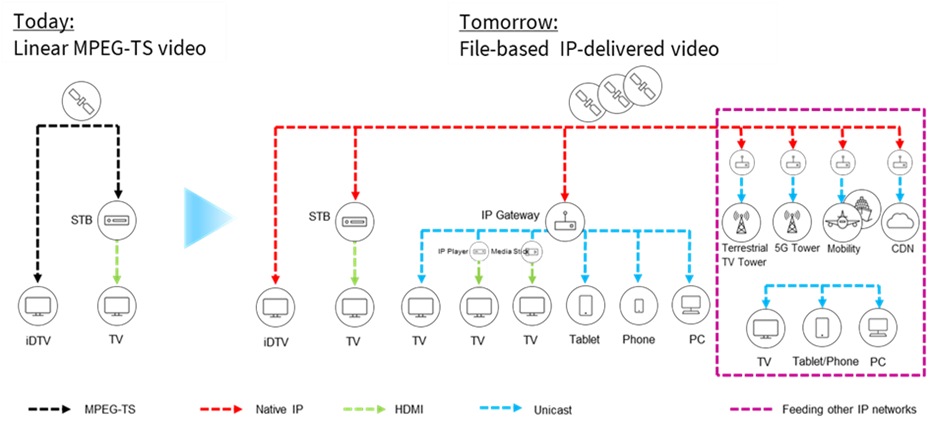Trends in Satellite Video Broadcasting
 Luxembourg, September 5, 2022--In many countries satellite video broadcasting is a major means of linear TV and radio delivery. But consumers today expect the convenience of watching linear and on-demand content on portable devices such as tablets, notebooks and mobile phones. Consequently, most video content providers now have dual-platform operations: a legacy (satellite) broadcast head-end, using MPEG Transport Stream delivery that serves integrated digital TVs or set-top boxes connected to consumers’ main room TV screens, and in addition an OTT streaming platform supporting live and on-demand content distribution, using unicast adaptive bit rate (ABR) streaming to mobile devices.
Luxembourg, September 5, 2022--In many countries satellite video broadcasting is a major means of linear TV and radio delivery. But consumers today expect the convenience of watching linear and on-demand content on portable devices such as tablets, notebooks and mobile phones. Consequently, most video content providers now have dual-platform operations: a legacy (satellite) broadcast head-end, using MPEG Transport Stream delivery that serves integrated digital TVs or set-top boxes connected to consumers’ main room TV screens, and in addition an OTT streaming platform supporting live and on-demand content distribution, using unicast adaptive bit rate (ABR) streaming to mobile devices.
Analyzing the recent financial results published by leading satellite operators shows that satellite video broadcasting is in a slow decline as consumers seem to shift towards OTT content delivery. What does this mean for satellite video broadcasting? On the one hand it needs a new broadcasting technology that allows video content to be delivered via satellite in a native IP format to all kinds of consumer IP device. Furthermore, there must be a new signaling mechanism that enables viewers to seamlessly find and watch television content, whether delivered over satellite or by any kind of broadband network including fiber and 5G.
A Native IP Broadcasting Standard
In February 2022 the Digital Video Broadcasting (DVB) group has published in its BlueBook A180 an end-to-end Native IP broadcast system referred to as DVB-NIP that facilitates broadcasting in IP format using existing industry standards such as mABR, DASH and CMAF. It relies as much as possible on existing DVB specifications and complements those where necessary.
 With the best of DVB broadcast (i.e., low latency, QoS, scalability and bandwidth resource optimization) and OTT streaming (enabling multiscreen and easy personalization) converging into a new Native IP broadcasting standard, there is the potential to create a future-proof, next generation broadcast solution. This solution could also work for terrestrial broadcast, potentially closing the existing “IP gap” in the DVB-T2 standard, a gap that the ATSC has already closed with its ATSC 3.0 standard several years ago.
With the best of DVB broadcast (i.e., low latency, QoS, scalability and bandwidth resource optimization) and OTT streaming (enabling multiscreen and easy personalization) converging into a new Native IP broadcasting standard, there is the potential to create a future-proof, next generation broadcast solution. This solution could also work for terrestrial broadcast, potentially closing the existing “IP gap” in the DVB-T2 standard, a gap that the ATSC has already closed with its ATSC 3.0 standard several years ago.
The vision of Native IP is that in future all linear video broadcast is delivered as file-based IP video reaching multiple viewing devices from a single broadcast platform.
The DVB-NIP broadcast system works in both connected and unconnected scenarios and supports a plethora of professional and consumer use cases. Its cores features comprise the following:
- Carriage of real-time live linear television and radio services,
- Real-time delivery of assets purely via broadcast,
- Real-time delivery of assets in a fully hybrid manner (some via broadcast and some via broadband),
- Direct content delivery from the same head-end to consumer homes or indirectly to CDN Edge Caches which make the content available via intermediate LAN or WAN fixed or mobile networks,
- In professional environments, the possibility to store received content, i.e. "Live to VoD" service,
- Support of an extended content guide (see DVB-I),
- Multiscreen support: Addresses Native IP devices with or without built-in broadcast tuner,
- Support of content protection with the same DRM solutions that are used on broadband networks (fully connected scenario),
- Support of proprietary DRM solutions for unconnected client scenarios.

The DVB-I Standard
The DVB-I standard was published in November 2019 in DVB’s BlueBook A177. The specification defines the signaling of linear TV or radio services and content that are delivered over broadband and accessing these services in a way that is fully consistent with their access when delivered by RF-based DVB technologies. Furthermore DVB-I defines the metadata and mechanisms to present electronic program guides (EPG). DVB-I allows for a single coherent offering of cable, satellite, terrestrial and broadband delivered content that consumers can access through a single user interface. It can also be a method for national TV regulators, operators and trademark licensors to offer a list of trusted and authorized DVB-I services.
Most importantly, DVB-I works with all delivery platforms enabling viewers to seamlessly find and watch television content, whether delivered via terrestrial, satellite or cable broadcast or any type of broadband network delivery. Using DVB-I, a broadcaster or operator can target smartphones, laptops, tablets, mobile phones, set-top-boxes, streaming sticks and TV sets with the same content offer.
via terrestrial, satellite or cable broadcast or any type of broadband network delivery. Using DVB-I, a broadcaster or operator can target smartphones, laptops, tablets, mobile phones, set-top-boxes, streaming sticks and TV sets with the same content offer.
It should be emphasized that DVB-I is also a central component of the DVB-NIP standard. This underlies the fact that the DVB group has an integrated strategy in developing a family of broadcast standards.
With DVB-I, consumers can have a single, consistent user interface on various types of devices. Terrestrial, cable and satellite operators can use DVB-I to leverage the strengths of hybrid content delivery within a single service offering.
Summary
With the Native IP standard DVB has laid the foundation for introducing a next generation of television broadcasting services. It would allow operators to save platform costs and at the same time reach all modern IP devices in consumers’ homes. In emerging markets operators can reach mobile users via hotspot gateways (basically a small satellite dish connected to a Native IP gateway plus WiFi) in public spaces. As Native IP is a new technology using DVB-S2 (with Multi-Protocol-Encapsulation MPE) or preferably DVB-S2X (with Generic Stream Encapsulation GSE (Lite)), its successful market introduction will require operators to commit to an additional transmission (e.g., a new dedicated satellite transponder). Furthermore, manufacturers will need to develop the required reception equipment such as home gateways with a satellite tuner that interfaces to the WiFi router in the home.
The good news is that all this is on its way and at the DVB stand at the IBC this year, visitors will be able to experience a live demonstration of DVB-NIP, DVB-I and other DVB technology.
References:
https://dvb-i.tv
https://www.etsi.org/deliver/etsi_ts/103700_103799/103770/01.01.01_60/ts_103770v010101p.pdf
https://dvb.org/wp-content/uploads/2022/02/A180_Native-IP-Broadcasting_Feb-2022.pdf
https://dvb.org/wp-content/uploads/2019/12/a177_dvb-i_specification.pdf
---------------------------------
 Thomas Wrede is the founder and managing director of Technology Vision Consulting, a company specialized in project studies, standardization and prototype developments in the fields of satellite communications and wireless technologies. Thomas has over 35 years of professional experience in the communications industry. In his 28 years at satellite operator SES in Luxembourg he has been deeply involved in the development of digital satellite television, in-home signal distribution concepts, digital satellite radio, satellite return channel technology, Internet via satellite and High Definition as well as Ultra High Definition (4K/8K) television. Thomas currently represents SES in the DVB Commercial Module (www.dvb.org) as chair of the CM-S subgroup. In his leisure time Thomas is an active amateur radio operator experimenting with software defined radio platforms and antenna designs. He can be reached at: thomas.wrede@me.com
Thomas Wrede is the founder and managing director of Technology Vision Consulting, a company specialized in project studies, standardization and prototype developments in the fields of satellite communications and wireless technologies. Thomas has over 35 years of professional experience in the communications industry. In his 28 years at satellite operator SES in Luxembourg he has been deeply involved in the development of digital satellite television, in-home signal distribution concepts, digital satellite radio, satellite return channel technology, Internet via satellite and High Definition as well as Ultra High Definition (4K/8K) television. Thomas currently represents SES in the DVB Commercial Module (www.dvb.org) as chair of the CM-S subgroup. In his leisure time Thomas is an active amateur radio operator experimenting with software defined radio platforms and antenna designs. He can be reached at: thomas.wrede@me.com





